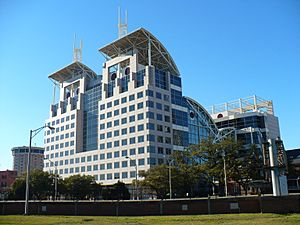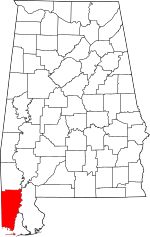Mobile County, Alabama facts for kids
Quick facts for kids
Mobile County
|
|||
|---|---|---|---|

Mobile Government Plaza in Mobile
|
|||
|
|||

Location within the U.S. state of Alabama
|
|||
 Alabama's location within the U.S. |
|||
| Country | |||
| State | |||
| Founded | December 18, 1812 | ||
| Named for | Mobile Bay | ||
| Seat | Mobile | ||
| Largest city | Mobile | ||
| Area | |||
| • Total | 1,644 sq mi (4,260 km2) | ||
| • Land | 1,229 sq mi (3,180 km2) | ||
| • Water | 415 sq mi (1,070 km2) 25.2% | ||
| Population
(2020)
|
|||
| • Total | 414,809 | ||
| • Estimate
(2023)
|
411,640 |
||
| • Density | 252.32/sq mi (97.420/km2) | ||
| Time zone | UTC−6 (Central) | ||
| • Summer (DST) | UTC−5 (CDT) | ||
| Congressional district | 1st | ||
|
|||
Mobile County is a county located in the southwest part of Alabama. It is the third-largest county in Alabama by population. In 2020, about 414,809 people lived here.
The main city and county seat is Mobile. This city was built as a deepwater port on the Mobile River. It is Alabama's only deepwater port. This port is very important for the economy. It connects to rivers inland and to the Gulf of Mexico.
The city, river, and county are named after Maubila. This was a village of the paramount chief Tuskaloosa. He was a leader of the Mississippian culture people. In 1540, he tried to stop Hernando de Soto's Spanish explorers. The Spanish had guns and many Native Americans were killed.
Mobile County and Washington County, Alabama, form the Mobile Metropolitan Statistical Area. In 2020, this area had 430,197 people. A larger area, the Mobile-Daphne-Fairhope CSA, had 661,964 people in 2020.
The northern part of Mobile County is home to the MOWA Band of Choctaw Indians. They are a state-recognized tribe. They are descendants of Choctaw and Creek people. These groups stayed in this area during the time of Indian Removal. They work to keep their culture and language alive. They were the first of nine tribes recognized by the state.
Contents
History of Mobile County
This area has been home to different indigenous peoples for thousands of years. In the early 1500s, the Mississippian culture lived here. They built large earth mounds. Their leader was Tuskaloosa.
Later, the historic Choctaw people lived here. They are believed to be related to the earlier groups. They lived along the river that French traders called the Mobile River. The French also started the settlement of Mobile in the early 1700s.
The British took control of this land in 1763. This happened after they won the Seven Years' War against the French. During the American Revolutionary War, Spain took over the area. It became part of Spanish Florida. After the War of 1812, Spain gave the land to the United States.
In the 1830s, the U.S. government forced many Native American tribes to move. This was part of President Andrew Jackson's policy. They were sent to Indian Territory west of the Mississippi River. However, many Native Americans stayed. They hid in the swamps between Mobile and Washington counties. Since the late 1900s, some tribes have reorganized. The MOWA Band of Choctaw Indians was recognized by the state in 1979. They have lived in this area for a long time.
Mobile County was officially created on December 18, 1812. This was done by the government of the Mississippi Territory. When Mississippi became a state in 1817, Mobile County became part of the Alabama Territory. Two years later, in 1819, Alabama became a state. Mobile County then became part of Alabama.
The city of Mobile was first settled by French colonists in the early 1700s. It was part of La Louisiane. Mobile was chosen as the county seat from the start. Both the county and city got their name from Fort Louis de la Mobile. This French fort was built in 1702. The word "Mobile" might come from a Choctaw word meaning "paddlers." French people lived here from 1702 to 1763. The British ruled from 1763 to 1780. The Spanish controlled the area from 1780 to 1813.
After the War of 1812, the United States took over. New settlers came to grow cotton. The invention of the cotton gin made cotton farming very profitable. Mobile became a big deepwater port. In the 1800s, cotton was its main export.
The county courthouse had fires in 1823, 1840, and 1872.
Geography of Mobile County

Mobile County covers about 1,644 square miles. About 1,229 square miles are land. The other 415 square miles (25.2%) are water. It is the fourth-largest county in Alabama by land area. It is the second-largest by total area. The county includes islands like Dauphin Island, Gaillard Island, and Mon Louis Island.
Major Roads in Mobile County
 Interstate 10
Interstate 10 Interstate 65
Interstate 65 Interstate 165
Interstate 165 U.S. Highway 43
U.S. Highway 43 U.S. Highway 45
U.S. Highway 45 U.S. Highway 90
U.S. Highway 90 U.S. Highway 98
U.S. Highway 98 State Route 158
State Route 158 State Route 163
State Route 163 State Route 188
State Route 188 State Route 193
State Route 193 State Route 213
State Route 213 State Route 217
State Route 217
Public Transportation
- The Wave Transit System
Neighboring Counties
- Washington County (north)
- Baldwin County (east)
- Jackson County, Mississippi (southwest)
- George County, Mississippi (west)
- Greene County, Mississippi (northwest)
Protected Natural Areas
Population of Mobile County
| Historical population | |||
|---|---|---|---|
| Census | Pop. | %± | |
| 1820 | 2,672 | — | |
| 1830 | 6,267 | 134.5% | |
| 1840 | 18,741 | 199.0% | |
| 1850 | 27,600 | 47.3% | |
| 1860 | 41,131 | 49.0% | |
| 1870 | 49,311 | 19.9% | |
| 1880 | 48,653 | −1.3% | |
| 1890 | 51,587 | 6.0% | |
| 1900 | 62,740 | 21.6% | |
| 1910 | 80,854 | 28.9% | |
| 1920 | 100,117 | 23.8% | |
| 1930 | 118,363 | 18.2% | |
| 1940 | 141,974 | 19.9% | |
| 1950 | 231,105 | 62.8% | |
| 1960 | 314,301 | 36.0% | |
| 1970 | 317,308 | 1.0% | |
| 1980 | 364,980 | 15.0% | |
| 1990 | 378,643 | 3.7% | |
| 2000 | 399,843 | 5.6% | |
| 2010 | 412,992 | 3.3% | |
| 2020 | 414,809 | 0.4% | |
| 2023 (est.) | 411,640 | −0.3% | |
| U.S. Decennial Census 1790–1960 1900–1990 1990–2000 2010–2020 |
|||
2020 Census Information
| Race / Ethnicity (NH = Non-Hispanic) | Pop 2000 | Pop 2010 | Pop 2020 | % 2000 | % 2010 | % 2020 |
|---|---|---|---|---|---|---|
| White alone (NH) | 249,763 | 243,904 | 226,703 | 62.47% | 59.06% | 54.65% |
| Black or African American alone (NH) | 132,845 | 142,272 | 145,435 | 33.22% | 34.45% | 35.06% |
| Native American or Alaska Native alone (NH) | 2,636 | 3,541 | 3,743 | 0.66% | 0.86% | 0.90% |
| Asian alone (NH) | 5,599 | 7,507 | 8,515 | 1.40% | 1.82% | 2.05% |
| Pacific Islander alone (NH) | 79 | 157 | 216 | 0.02% | 0.04% | 0.05% |
| Other race alone (NH) | 319 | 428 | 1,302 | 0.08% | 0.10% | 0.31% |
| Mixed race or Multiracial (NH) | 3,715 | 5,247 | 15,470 | 0.93% | 1.27% | 3.73% |
| Hispanic or Latino (any race) | 4,887 | 9,936 | 13,425 | 1.22% | 2.41% | 3.24% |
| Total | 399,843 | 412,992 | 414,809 | 100.00% | 100.00% | 100.00% |
In 2020, there were 414,809 people living in Mobile County. There were 163,750 households. The population density was about 337.4 people per square mile.
The largest city in the county is Mobile. Its population was 187,041 in 2020. More than half of its residents (51.06%) are African-American.
2010 Census Information
According to the 2010 census, the county's population included:
- 60.2% White
- 34.6% Black
- 0.9% Native American
- 1.8% Asian
- 0.0% Native Hawaiian or Pacific Islander
- 1.5% Two or more races
- 2.4% Hispanic or Latino (of any race)
Education in Mobile County
Most schools in Mobile County are run by the Mobile County Public School System. However, some cities have their own school systems. These include Chickasaw, Saraland, and Satsuma. They are served by Chickasaw City Schools, Saraland Board of Education, and Satsuma City School System.
Mobile County is home to several colleges and universities:
- University of South Alabama (USA): This is a public research university. It has ten colleges, including a medical school. Over 16,000 students attend USA. It employs more than 6,000 staff members.
- Spring Hill College: This is a private Catholic college. It was founded in 1830. It is one of the oldest Jesuit colleges in the U.S. About 1,500 students attend here. It offers 46 different study programs.
- University of Mobile: This is another private university. It was started in 1961. It is connected with the Alabama Baptist Convention. About 2,000 students attend. It offers 90 different study programs.
Communities in Mobile County
Cities
- Bayou La Batre
- Chickasaw
- Citronelle
- Creola
- Mobile (county seat)
- Prichard
- Saraland
- Satsuma
- Semmes
Towns
Census-Designated Places (CDPs)
- Axis
- Belle Fontaine
- Bucks
- Calvert (partly in Washington County)
- Chunchula
- Grand Bay
- Gulfcrest
- Movico
- Theodore
- Tillmans Corner
Unincorporated Communities
- Alabama Port
- Churchill Downs
- Cloverdale
- Coden
- Crawford
- Eight Mile
- Fernland
- Heron Bay
- Irvington
- Kushla
- Le Moyne
- Lloyds
- Mauvilla
- Mon Louis
- Pennsylvania
- St. Elmo
- Tanner Williams
- Union Church
- Whistler
- Wilmer
Ghost Town
See also
 In Spanish: Condado de Mobile para niños
In Spanish: Condado de Mobile para niños



